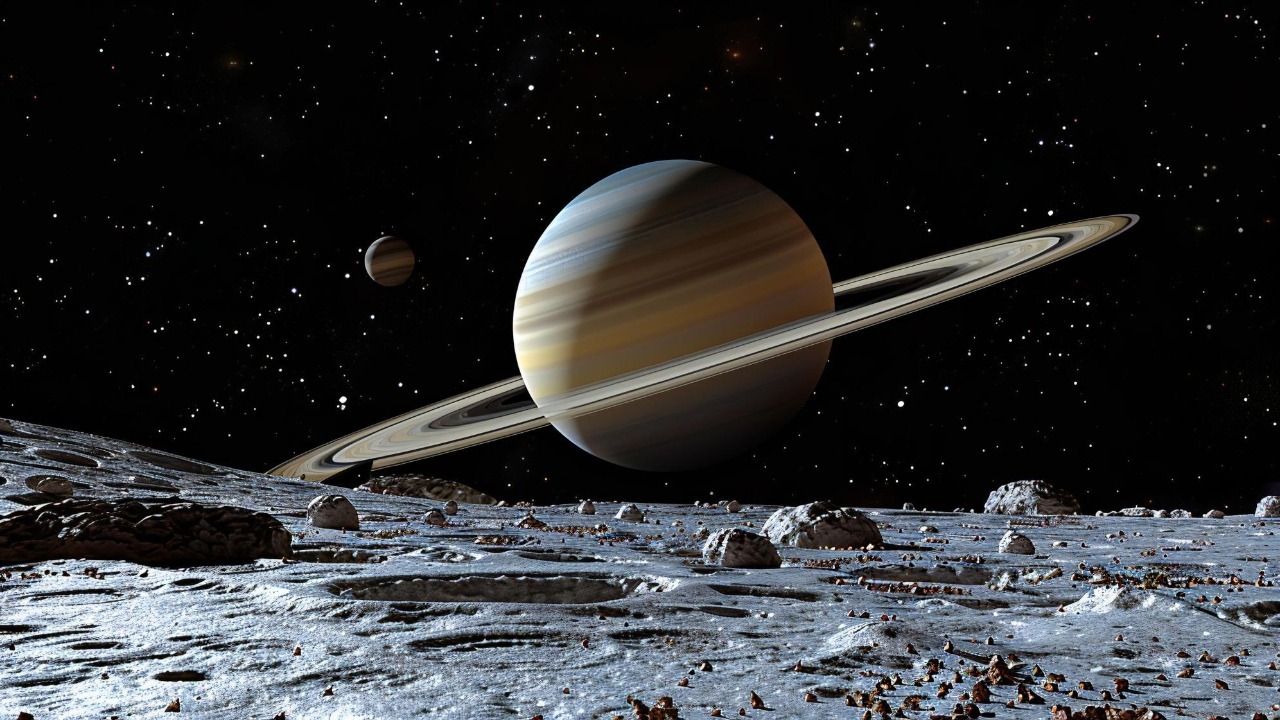
Recent observations have revealed that the chemistry on Saturn’s moon Titan is more complex and unusual than previously understood. These findings challenge existing models of atmospheric and surface processes on this distant world. The unconventional reactions observed on Titan could mimic prebiotic conditions similar to those on early Earth, offering new insights into the potential origins of life. While Titan’s chemistry is currently a hot topic, earlier evidence from Saturn’s moon Enceladus also points to the presence of key ingredients for life, providing a broader context for understanding the habitability of Saturn’s moons.
Unconventional Chemical Reactions on Titan
The chemistry on Titan deviates significantly from standard expectations, particularly in its thick nitrogen-rich atmosphere. Recent observations highlight how Titan’s hydrocarbon hazes and surface organics behave atypically under the moon’s frigid conditions. These findings, reported on October 21, 2025, suggest that the chemistry on Titan is even stranger than we thought. The interactions between solar radiation and Titan’s unique atmospheric composition appear to drive these anomalies, leading to unexpected molecular interactions that defy conventional understanding. This peculiar chemistry challenges scientists to rethink the processes that govern atmospheric and surface reactions on Titan.
One of the most intriguing aspects of Titan’s chemistry is the presence of hydrocarbon hazes that form in its atmosphere. These hazes are composed of complex organic molecules that interact in ways not typically seen in other planetary atmospheres. The energy driving these reactions likely comes from the interplay between solar radiation and Titan’s atmospheric components, which include nitrogen and methane. This interaction results in a rich tapestry of chemical processes that could provide clues about the moon’s potential for harboring life or prebiotic conditions.
Rule-Breaking Processes in Titan’s Environment
Titan’s environment is home to chemical processes that break the rules of traditional chemistry. In particular, the lakes of liquid methane and ethane on Titan’s surface exhibit reaction kinetics that defy typical expectations. An analysis from October 20, 2025, underscores the presence of non-standard bonding and catalysis occurring on Titan’s surface. These processes are facilitated by the moon’s extreme low temperatures, which hover around -179°C, enabling chemical irregularities that would not occur under Earth-like conditions. This unique environment allows for the formation of complex organic molecules that could be precursors to life.
The extreme cold on Titan plays a crucial role in enabling these rule-breaking chemical processes. At such low temperatures, reactions that would normally require higher energy inputs can occur more readily. This allows for the formation of unusual molecular structures and interactions that challenge our understanding of chemistry. The presence of liquid methane and ethane lakes further complicates the picture, as these bodies of liquid provide a medium for chemical reactions that are not possible in more typical environments. These findings suggest that Titan’s surface is a dynamic and chemically rich environment that could offer insights into the origins of life.
Implications for Origins of Life
The strange chemistry observed on Titan may hold clues to how life began. The unconventional reactions and molecular interactions on Titan resemble scenarios that could have occurred in the primordial soup of early Earth. The October 20, 2025, report suggests that Titan’s environment may reveal how life began through the spontaneous formation of organic polymers. These polymers, composed of carbon, nitrogen, and hydrogen compounds, could serve as the building blocks for more complex molecules necessary for life.
Comparing Titan’s prebiotic-like conditions to those on early Earth highlights the moon’s potential as a natural laboratory for studying the origins of life. Titan’s abundance of organic compounds, combined with its unique atmospheric and surface chemistry, creates an environment where complex molecules could assemble. The presence of dunes and seas on Titan’s surface provides additional opportunities for chemical interactions that could lead to the formation of life’s precursors. These findings underscore the importance of studying Titan as a model for understanding the processes that may have led to the emergence of life on Earth.
Comparative Chemistry on Saturn’s Moons
While Titan’s chemistry is fascinating, it is not the only moon in Saturn’s system that holds potential for life. Evidence from December 15, 2023, shows that Saturn’s moon Enceladus also contains key ingredients for life. Phosphorus and other elements have been detected in the subsurface ocean plumes of Enceladus, suggesting a water-based chemistry that contrasts with Titan’s organic-dominated environment. This diversity in chemical environments across Saturn’s moons highlights the system’s potential for supporting life through various astrochemical pathways.
The differences between Enceladus and Titan illustrate the range of chemical processes that can occur in the Saturn system. Enceladus’s water-rich environment provides a stark contrast to Titan’s hydrocarbon-rich atmosphere, offering a complementary perspective on the potential for life. The shared orbital influences between these moons may facilitate the exchange of materials, enhancing their habitability prospects. By studying both Titan and Enceladus, scientists can gain a more comprehensive understanding of the conditions that could support life in the outer solar system.